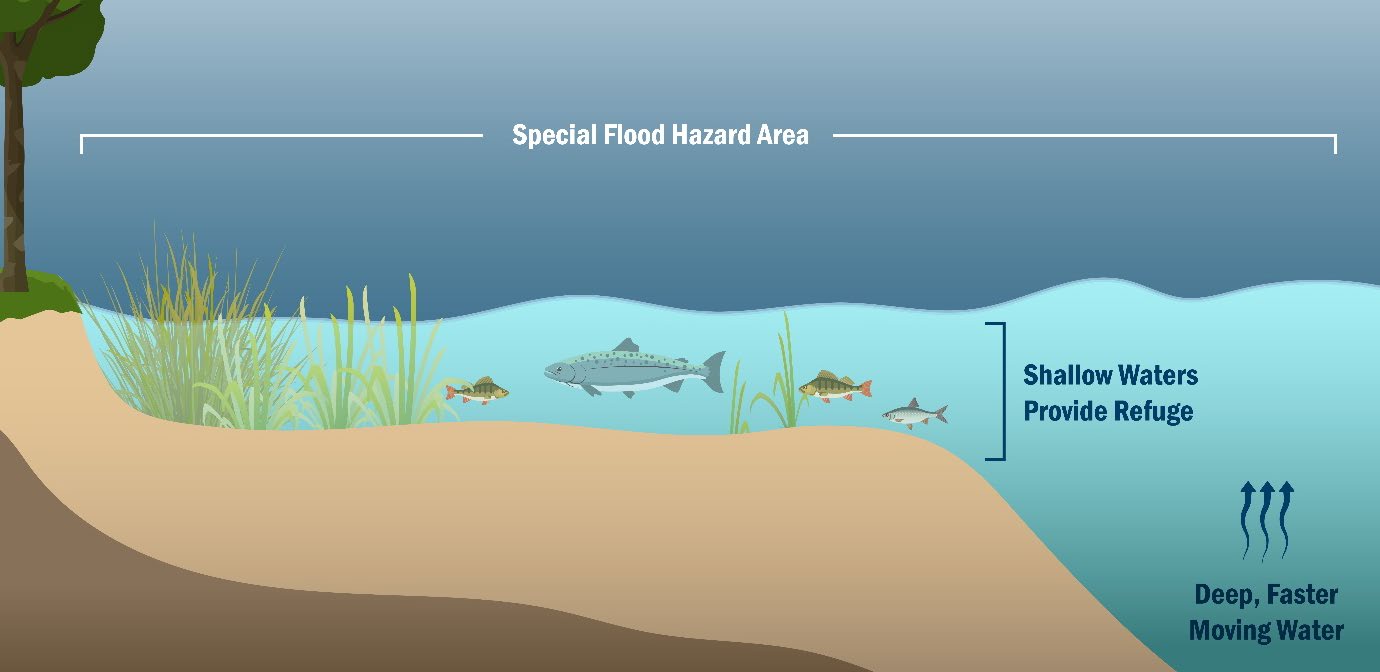FEMA invites public comment on plan that could affect development in Special Flood Hazard Areas

Updated September 9, 2025
The Federal Emergency Management Agency wants your input as they develop an updated environmental impact statement (EIS) and implementation plan for the National Flood Insurance Program (NFIP). Public comments can be submitted through October 6.
The draft implementation plan will impact the cost of building structures, septic systems, driveways, parking areas and more in floodplain areas. Community members can learn about FEMA’s proposed options and share verbal comments at a series of virtual public meetings throughout September. There are also several ways to share written comments.
FEMA is analyzing the effects of proposed changes to the implementation of the NFIP in Oregon. The changes will incorporate mitigation requirements to comply with the Endangered Species Act and the Magnuson-Stevens Fishery Conservation and Management Act.
The changes are meant to limit the negative impacts of development on habitat in floodplains. Floodplains are areas of land next to a river or stream that experience periodic flooding when the water level rises. Development includes building and renovating homes, garages, shops or barns and improving riparian habitat. It also includes use of the land for businesses, agriculture, forestry, recreation or transportation.
The proposed changes will protect three natural floodplain functions:
- Storing flood water
- Acting as natural filters that improve water quality and help replenish groundwater aquifers
- Supporting vegetation that provides essential habitats for a wide range of plant and animal species, including fish
FEMA’s proposed changes
Potential changes proposed in FEMA’s draft documents include:
- “No net loss” standards for development to avoid or mitigate adverse impacts to the three floodplain functions. Complying with these standards requires that adverse impacts must be avoided or offset through mitigation so that there is no net loss in the habitat function.
- Additional vegetation requirements for non-water dependent uses in the Riparian Buffer Zone (the land within 170 feet of the ordinary high water mark of a waterbody).
The original implementation plan was developed by FEMA between 2016 and 2021 with input from the State of Oregon and public stakeholders. FEMA has now released an updated draft that includes new information, definitions and examples for implementation. The draft implementation plan offers communities four possible paths for compliance and provides examples of how to apply the proposed changes to a variety of development projects.
Draft plans affect the Willamette Valley
The proposed changes will affect all development in areas mapped as Special Flood Hazard Areas — often called 100-year floodplains — on FEMA’s flood insurance rate maps.
People living and working in the Willamette Valley, including Benton County, are in the Implementation Plan Area. It includes the six NOAA Salmon and Steelhead Recovery Domains within the State of Oregon: Willamette River, Oregon Coast, Southern Oregon/Northern California Coast, Lower Columbia River, Middle Columbia River and Snake River.
How to comment
Communities, agencies and the public are encouraged to review and comment on the draft documents by October 6. FEMA invites comments on the alternatives and their potential benefits and impacts on people, endangered species and the environment. Comments should be specific and inform FEMA’s selection among the three alternatives.
There are several opportunities for public engagement:
- Visit the virtual open house to learn more about the Draft EIS and the Draft Implementation Plan for NFIP-ESA Integration.
- Mail: NFIP OR-EIS, FEMA, Region 10, 130 – 228th Street SW, Bothell, WA 98021
- Fax: 425-775-7560 Attention: FEMA NFIP OR EIS
- Comment verbally at a virtual public meeting or just listen in to find out what’s going on. Use one of these links to register (required):
- Saturday, Sept. 6, 11 a.m. to 1 p.m. PDT
- Monday, Sept. 8, 10 a.m. to noon PDT
- Thursday, Sept. 11, 9 a.m. PDT – special interest meeting for environmental & nonprofit groups
- Thursday, Sept. 11, 11 a.m. PDT – special interest meeting for business & industry (contractors, surveyors, realtors, insurance agents, business owners, etc.)
- Thursday, Sept. 11, 6 to 8 p.m. PDT
- Tuesday, Sept. 30, 6 to 8 p.m. PDT
FEMA will consider all input received during the Draft EIS public review and comment period. Following the public review and comment period on the Draft EIS, FEMA will develop a Final EIS, identify a preferred alternative, and publish a Record of Decision to conclude the NEPA process.
More information is available on the FEMA website: https://www.fema.gov/about/organization/region-10/oregon/nfip-esa-integration
Contact:
Toby Lewis, Floodplain Administrator
541-766-6819
toby.lewis@bentoncountyor.gov
